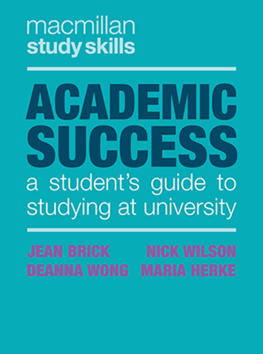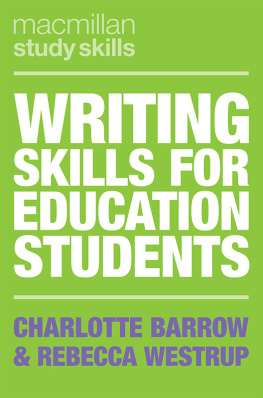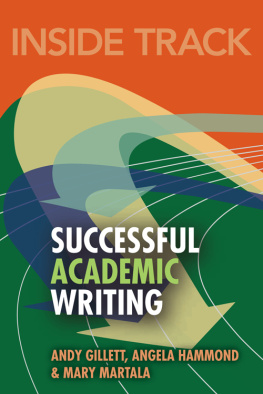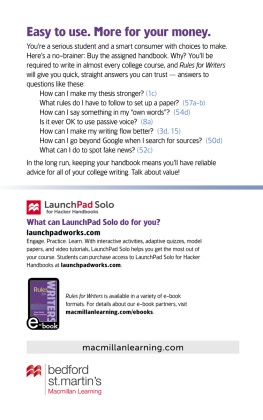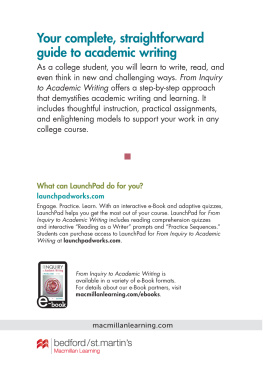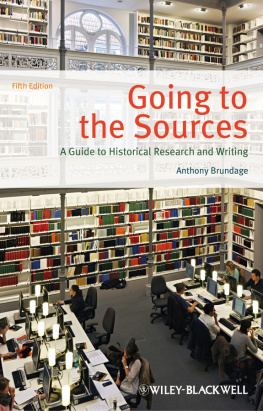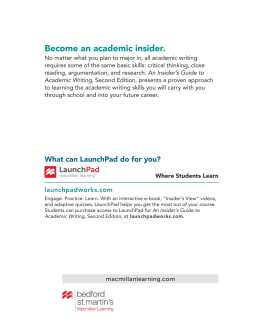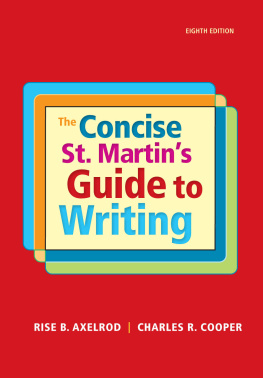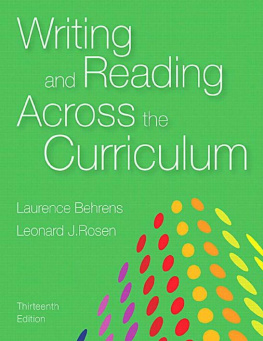How to Use your Reading in your Essays
www.palgravestudyskills.comthe leading study skills website
Palgrave Study Skills
Business Degree Success
Career Skills
Cite Them Right (9th edn)
Critical Thinking Skills (2nd edn)
e-Learning Skills (2nd edn)
The Exam Skills Handbook (2nd edn)
The Graduate Career Book
Great Ways to Learn Anatomy and Physiology
How to Begin Studying English Literature (3rd edn)
How to Manage Your Distance and Open Learning Course
How to Manage Your Postgraduate Course
How to Study Foreign Languages
How to Study Linguistics (2nd edn)
How to Use Your Reading in Your Essays (2nd edn)
How to Write Better Essays (3rd edn)
How to Write Your Undergraduate Dissertation
Improve Your Grammar
Information Skills
The International Student Handbook
IT Skills for Successful Study
The Mature Students Guide to Writing (3rd edn)
The Mature Students Handbook
The Palgrave Student Planner
Practical Criticism
Presentation Skills for Students (2nd edn)
The Principles of Writing in Psychology Professional Writing (2nd edn)
Researching Online
Skills for Success (2nd edn)
The Students Guide to Writing (3rd edn)
The Student Phrase Book
Study Skills Connected
The Study Skills Handbook (4th edn)
Study Skills for International Postgraduates
Study Skills for Speakers of English as a Second Language
Studying History (3rd edn)
Studying Law (3rd edn)
Studying Modern Drama (2nd edn)
Studying Psychology (2nd edn)
Teaching Study Skills and Supporting Learning
The Student Phrase Book
The Undergraduate Research Handbook
The Work-Based Learning Student Handbook
Work Placements A Survival Guide for Students
Write it Right (2nd edn)
Writing for Engineers (3rd edn)
Writing for Law
Writing for Nursing and Midwifery Students (2nd edn)
You2Uni
Pocket Study Skills
14 Days to Exam Success
Blogs, Wikis, Podcasts and More
Brilliant Writing Tips for Students
Completing Your PhD
Doing Research
Getting Critical
Planning Your Essay
Planning Your PhD
Reading and Making Notes
Referencing and Understanding Plagiarism
Reflective Writing
Report Writing
Science Study Skills
Studying with Dyslexia
Success in Groupwork
Time Management
Writing for University
Palgrave Research Skills
Authoring a PhD
Getting to Grips with Doctoral Research
The Foundations of Research (2nd edn)
The Good Supervisor (2nd edn)
The Postgraduate Research Handbook (2nd edn)
Structuring Your Research Thesis
For a complete listing of all our titles in this area please visit www.palgrave.com/studyskills
How to Use your Reading in your Essays
Second edition
Jeanne Godfrey


Jeanne Godfrey 2013
All rights reserved. No reproduction, copy or transmission of this publication may be made without written permission.
No portion of this publication may be reproduced, copied or transmitted save with written permission or in accordance with the provisions of the Copyright, Designs and Patents Act 1988, or under the terms of any licence permitting limited copying issued by the Copyright Licensing Agency, Saffron House, 6 10 Kirby Street, London EC1N 8TS.
Any person who does any unauthorized act in relation to this publication may be liable to criminal prosecution and civil claims for damages.
The author has asserted her right to be identified as the author of this work in accordance with the Copyright, Designs and Patents Act 1988.
First published 2013 by
PALGRAVE MACMILLAN
Palgrave Macmillan in the UK is an imprint of Macmillan Publishers Limited, registered in England, company number 785998, of Houndmills, Basingstoke, Hampshire RG21 6XS.
Palgrave Macmillan in the US is a division of St Martins Press LLC, 175 Fifth Avenue, New York, NY 10010.
Palgrave Macmillan is the global academic imprint of the above companies and has companies and representatives throughout the world.
Palgrave and Macmillan are registered trademarks in the United States, the United Kingdom, Europe and other countries
ISBN: 978 1 137294685
This book is printed on paper suitable for recycling and made from fully managed and sustained forest sources. Logging, pulping and manufacturing processes are expected to conform to the environmental regulations of the country of origin.
A catalogue record for this book is available from the British Library.
A catalog record for this book is available from the Library of Congress.
10 9 8 7 6 5 4 3 2 1
22 21 20 19 18 17 16 15 14 13
Printed in China
For my family
Acknowledgements
This second edition, as in the first, is a product of the knowledge and experience I have gained over the years. I would, therefore, like to thank all the students I have taught, and colleagues and other experts in the field whose work I have read, discussed and pondered as I progress in my own understanding. I would also like to thank again the Palgrave Macmillan team for their support in bringing this second edition to publication, especially Suzannah Burywood, Della Oliver and Alec McAulay.
Introduction: an exampleand overview of how reading is used in an essay
A fundamental part of academic study is reading other peoples work on a subject and using what you have read to develop your own thinking and writing. This book will take you through the process of using what you read in your written work, from deciding what to read to checking your work for mistakes. How to Use your Reading in your Essays looks specifically at using your reading in non-exam essays, but the information it gives is also relevant to most types of academic writing across most subject areas. This book will increase your knowledge of how to use the chapters, books and articles you read effectively, and will thereby give you the confidence to produce good writing and to get the highest marks possible for your work.
This book will show you:
- how to decide which types of books and articles are suitable to read for your essays and which are probably not;
- how to understand and question what you read;
- what information to write down and how to make notes that enable you to use your reading properly and effectively in your essays;
- why, when and how to use quotations in your essays;
- why, when and how to put what you read into your own words;
- why, when and how to integrate your own points with ideas from your reading;
- words and phrases to use when you are integrating and evaluating your reading;
- brief explanations of grammatical areas that often cause problems in student writing;
- examples of common mistakes to check for and to avoid in your own work.
How to Use your Reading in your Essays takes you through the process of using your reading in clear stages, and gives you key points, examples and practice exercises, using real texts and student essays. It explains simply and clearly both the why of using your reading and the practical how of doing so.
In ) I have included some adapted material from my book The Student Phrase Book, 2013.
The rest of this introductory section gives you an example and overview of how reading is used in a non-exam essay and gives you points to remember when you are writing your own assignments.
Next page

